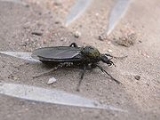
Bibionomorpha
Encyclopedia
Bibionomorpha is an infraorder of Nematocera
. One of its constituent families, the Anisopodidae
, is the presumed sister taxon to the entire suborder Brachycera
. Several of the remaining families in the infraorder (those shown without common name
s) are former subfamilies of the Mycetophilidae
, which has been recently subdivided. The family Axymyiidae
has recently been removed from the Bibionomorpha to its own infraorder Axymyiomorpha.
Most of the flies in the Bibionomorpha are saprophages or fungivore
s as larva
e, aside from the Cecidomyiidae
, which are gall
-formers. Some sciarids
are common indoor pests, developing large populations in potting soil that has become moldy from overwatering. The larave of Bibionidae
sometimes migrate in large snakelike masses in order to minimize dehydration while seeking a new feeding site.
Nematocera
Nematocera , is a suborder of elongated flies with thin, segmented antennae and mostly aquatic larvae, consisting of the mosquitoes, crane flies, gnats, and midges....
. One of its constituent families, the Anisopodidae
Anisopodidae
Anisopodidae is a small cosmopolitan family of gnat-like flies known as wood gnats or window-gnats with 154 described extant species in 15 genera, and several described fossil taxa. Some species are saprophagous or fungivorous. They are mostly small to medium-sized flies, except the genera...
, is the presumed sister taxon to the entire suborder Brachycera
Brachycera
Brachycera is a suborder of Diptera. It is a major suborder consisting of around 120 families. The most distinguishing characteristic of the suborder is reduced antenna segmentation...
. Several of the remaining families in the infraorder (those shown without common name
Common name
A common name of a taxon or organism is a name in general use within a community; it is often contrasted with the scientific name for the same organism...
s) are former subfamilies of the Mycetophilidae
Mycetophilidae
Mycetophilidae is a family of small flies, forming the bulk of those species known as fungus gnats. There are approximately 3000 described species in 150 genera but the true number of species is undoubtedly much higher...
, which has been recently subdivided. The family Axymyiidae
Axymyiidae
The Nematoceran family Axymyiidae is the sole member of the infraorder Axymyiomorpha, though it is often included within the infraorder Bibionomorpha in older classifications. It is known from only 6 species in 3 genera, plus 3 fossil species....
has recently been removed from the Bibionomorpha to its own infraorder Axymyiomorpha.
Most of the flies in the Bibionomorpha are saprophages or fungivore
Fungivore
A fungivore or mycophage is any animal that primarily or solely feeds upon living members of the fungus kingdom. Fungivory is a type of predation, and is an important part of the soil food web...
s as larva
Larva
A larva is a distinct juvenile form many animals undergo before metamorphosis into adults. Animals with indirect development such as insects, amphibians, or cnidarians typically have a larval phase of their life cycle...
e, aside from the Cecidomyiidae
Cecidomyiidae
Cecidomyiidae is a family of flies known as gall midges or gall gnats. As the name implies, the larvae of most gall midges feed within plant tissue, creating abnormal plant growths called galls.These are very fragile small insects usually only 2–3 mm in length and many are less than...
, which are gall
Gall
Galls or cecidia are outgrowths on the surface of lifeforms caused by invasion by other lifeforms, such as parasites or bacterial infection. Plant galls are abnormal outgrowths of plant tissues and can be caused by various parasites, from fungi and bacteria, to insects and mites...
-formers. Some sciarids
Sciaridae
Sciaridae is a family of flies, commonly known as dark-winged fungus gnats. Commonly found in moist environments, they are known to be a pest of mushroom farms and are commonly found in household plant pots. This is one of the least studied of the large Diptera families, probably due to the small...
are common indoor pests, developing large populations in potting soil that has become moldy from overwatering. The larave of Bibionidae
Bibionidae
Bibionidae is a family of flies . Approximately 650-700 species are known worldwide.-Biology:...
sometimes migrate in large snakelike masses in order to minimize dehydration while seeking a new feeding site.
Extinct families
The extinct bibionomorph fauna follows:-
- Cascopleciidae Middle? Cretaceous; Myanmar
- Eopleciidae extinct (Lower Jurassic)
- Oligophryneidae extinct (Upper Triassic)
- Paraxymyiidae extinct (Middle Jurassic)
- Protobibionidae extinct (Middle Jurassic)
- Protopleciidae extinct (Pan Jurassic)
- Protorhyphidae extinct (Upper Triassic)
- Protoscatopsidae extinct (Middle Jurassic)
- Superfamily Pleciodictyidea extinct
- Pleciodictyidae - (Upper Triassic)
- Superfamily Protoligoneuridea extinct
- Protoligoneuridae - (Upper Triassic)
- Superfamily Fungivoridea
- Pleciofungivoridae extinct (Upper Triassic) (Lower and Middle Jurassic)
- Palaeopleciidae extinct (Upper Triassic)
- Pleciomimidae extinct (Lower and Middle Jurassic)
- Archizelmiridae extinct (Middle Jurassic)
- Fungivoritidae extinct (Middle and Upper Jurassic)
- Tipulopleciidae extinct (Middle Jurassic)
- Sinemediidae extinct (Middle Jurassic)

